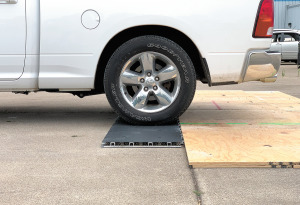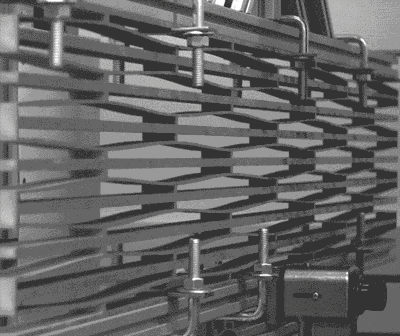Subscriber Benefit
As a subscriber you can listen to articles at work, in the car, or while you work out. Subscribe Now
Purdue University civil engineering researchers are seeking patents for an “intelligent” architected materials technology that can withstand severe bending, compression, torque and other stresses without permanent deformation or damage. The materials can even “remember” their shapes, allowing them to snap back to their original forms after being damaged.
“You can think of these architectural materials as little buildings, like little structures,” said Pablo Zavattieri, Purdue’s Jerry M. and Lynda T. Englehardt professor in civil engineering, who leads the team that developed the technology. “You have columns, beams, trusses. Basically, what we do is design them at a micron scale, so that they have emergent microscopic behavior that is different from the base material.”
To put it simply, the technology improves on a technique used in nature to magnify both the strength and flexibility of materials like wood and bones.
For instance, bones contain an intricate latticework of empty chambers that make them lighter while also allowing them to endure a great deal of strain and even deformation before breaking. Zavattieri’s technology applies advanced design techniques to create optimized versions of such tiny internal structures in everything from wood to rubber to steel.
Cars, for example, currently absorb the energy of a crash by collapsing the car frame. This certainly works, but the damage can’t be undone. A car body embedded with these advanced architectural shapes could, in theory, not just absorb the energy of a crash but also snap back to the car’s original form.

“Such materials are designed for fully recoverable, energy-dissipating structures akin to what is called architectural shape-memory materials, or phase transforming cellular materials, called PXCMs,” Zavattieri said. “They can also exhibit intelligent responses to external forces, such as changes in temperature and other stimuli.”
Such highly resilient materials could be used in biomedical devices (which could be condensed to a tiny size, then “deployed” into their final form after being injected into the body), outer space structures, sporting goods, automotive components and construction materials.
It could even be used to increase the flexibility of compounds as rigid as concrete.
“It’s tougher trying to get this behavior out of concrete, because it’s typically brittle,” Zavattieri said. “That means the elastic limit is limited. But we can design them so that they behave like springs. In principle, you can do that.”
His team has produced intelligent architected materials up to a foot long, making them potentially useful for applications like building and bridge construction. On the other end of the spectrum, the team has developed materials smaller than the thickness of a human hair.
“This scalability opens up a world of possibilities for macro and micro applications,” Zavattieri said.

The technique has already attracted lots of government and industry attention. The research has received funding from, among others, General Motors, the National Science Foundation and the U.S. Air Force. A collaboration that includes Zavattieri, the Air Force, and Indiana Technology and Manufacturing Companies is using metal 3D-printed runway mats to construct temporary runways. The carbon-fiber-reinforced metal composites are lightweight but stiff and able to bounce back from hard landings and other potential damage.
Field tests revealed the mats can withstand more than 5,000 landing and takeoff cycles over a 60-day period without showing signs of failure. The conventional temporary mats used by the Air Force and others fail after roughly 1,500 cycles.
“I think if we keep developing this, we should be able to put it into real applications,” Zavattieri said.
His team is also working on another project with possible military uses—non-pneumatic tires, or tires that are supported by their own internal structure instead of air pressure. The obvious advantage is that nobody can shoot out your tires if they aren’t filled with air. Also, a “solid” tire might be much more resilient than conventional designs. Computer-based modeling has so far demonstrated that PXCM tires would work well both on roads and off, and could continue to function with as much as 20% of the tire missing—either from road debris or ballistic or explosive damage.
On the civilian side, some construction-industry experts question how quickly the technology would be adapted in their field.

“I think some clients are looking for ways to innovate, but many will shy away from new products and materials because of the higher costs associated with them,” said Jennifer Goodman, lead editor of the industry magazine Construction Dive.
That goes double since the pandemic, which caused prices for construction materials to skyrocket—if they could be found at all. It made clients and contractors doubly committed to sticking with products that are as easy to source as they are relatively cheap.
“In addition, most contractors historically have not been as receptive to change, as it adds time and headaches to projects,” Goodman said. “But some are embracing it, especially along the lines of artificial intelligence, robotics and building information monitoring.”
Since builders already use durable construction materials, it might be a while before one sees cutting-edge PXCM-inspired products used in buildings.

“There are more advanced ways to frame a house, but people are still framing them like they did in the 1960s or even earlier,” said Brandon Farley, education studio practice leader at the Indianapolis-headquartered full-service architecture and engineering firm American Structurepoint. “It’s easier to take the safe method than to go out on a limb and try something experimental.”
Unless, of course, that experimental product presents an open-and-shut value-added case. Like drywall did.
“Drywall replaced plaster, which is very labor-intensive, very heavy and very difficult,” Farley said. “You can drywall a house very quickly and comparatively cheaply, so it made financial sense for everybody to embrace it.”
He said PEX piping, a form of flexible plastic hosing that can replace most copper and PVC internal plumbing, followed a similar fast track in adoption. It was cheaper, and it takes a lot less skill and time to install it than does welding and soldering metal pipes.
“When they came out with this new piping technology, everybody jumped on board,” Farley said. “It’s often easier to get people to do that if there’s an obvious financial case to be made. You’d have to figure out what’s going to make a good financial case for these new products to get people to take a chance and adopt them. It’s worth taking a chance if the upside is huge.”
For his part, Zavattieri sees a bright future for the technology. At some point, he might even entertain the idea of starting his own company to pursue the work.
“If the opportunity comes along, I will probably take a look at it,” he said. “At this point, I just want to make it clear that we are developing this technology and working to make it available for real applications. I’m worried right now about bridging that gap. But if we have the opportunity, I might consider a business. Why not?”•
Please enable JavaScript to view this content.
